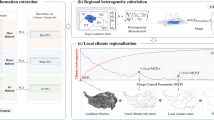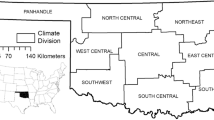Abstract
Trends of annual and monthly temperature, precipitation, potential evapotranspiration and aridity index were analyzed to understand climate change during the period 1971–2000 over the Tibetan Plateau which is one of the most special regions sensitive to global climate change. FAO56-Penmen-Monteith model was modified to calculate potential evapotranspiration which integrated many climatic elements including maximum and minimum temperatures, solar radiation, relative humidity and wind speed. Results indicate generally warming trends of the annual averaged and monthly temperatures, increasing trends of precipitation except in April and September, decreasing trends of annual and monthly potential evapotranspiration, and increasing aridity index except in September. It is not the isolated climatic elements that are important to moisture conditions, but their integrated and simultaneous effect. Moreover, potential evapotranspiration often changes the effect of precipitation on moisture conditions. The climate trends suggest an important warm and humid tendency averaged over the southern plateau in annual period and in August. Moisture conditions would probably get drier at large area in the headwater region of the three rivers in annual average and months from April to November, and the northeast of the plateau from July to September. Complicated climatic trends over the Tibetan Plateau reveal that climatic factors have nonlinear relationships, and resulte in much uncertainty together with the scarcity of observation data. The results would enhance our understanding of the potential impact of climate change on environment in the Tibetan Plateau. Further research of the sensitivity and attribution of climate change to moisture conditions on the plateau is necessary.
Similar content being viewed by others
References
Allen R G, Pereira L S, Raes D et al., 1998. Crop Evapotranspiration-Guidelines for Computing Crop Water Requirements. FAO Irrigation and drainage paper 56. Rome: United Nations Food and Agriculture Organization. 300 pp.
Bi Siwen, 1997. A best laboratory of the universal research for the earth’s global change and earth system science: The Qinghai-Tibet Plateau. System Engineering Theory and Practice, 17(5): 72–77. (in Chinese)
Boyles R P, Raman S, 2003. Analysis of climate trends in North Carolina (1949–1998). Environment International, 29(2–3): 263–275.
Cai Ying, Li Dongliang, Tang Maocang et al., 2003. Decadal temperature changes over Qinghai-Xizang Plateau in recent 50 years. Plateau Meteorology, 22(5): 464–470. (in Chinese)
Du Jun, Ma Yucai, 2004. Climatic trend of rainfall over Tibetan Plateau from 1971–2000. Acta Geographica Sinica, 59(3): 375–382. (in Chinese)
Feng Song, Tao Maocang, Wang Dongmei, 1998. New evidence for the Qinghai-Xizang (Tibet) Plateau as a pilot region of climatic fluctuation in China. Chinese Science Bulletin, 43(6): 633–636.
Fennessey N M, Kirshen P H, 1994. Evaporation and evapotranspiration under climate change in New England. Journal of Water Resources Planning and Management, 120(1): 48–69.
Goyal R K, 2004. Sensitivity of evapotranspiration to global warming: A case study of arid zone of Rajasthan (India). Agricultural Water Management, 69(1): 1–11.
Huang Bingwei, 1959. Draft of the complex physical geographical division of China. Chinese Science Bulletin, 18: 594–602. (in Chinese)
Hulme M, Barrow E M, Arnell N W et al., 1999. Relative impacts of human-induced climate change and natural climate variability. Nature, 397(6721): 688–691.
Jensen M E, Burman R D, Allen R G, 1990. Evapotranspiration and irrigation requirements. ASCE Manuals and Reports on Engineering Practice No. 70. New York: American Society of Civil Engineer. 360 pp.
Jones P D, Reid P A, 2001. Temperature trends in regions affected by increasing aridity/humidity. Geophysical Research Letters, 28(20): 3919–3922.
Kang Shichang, Li Jijun, Yao Tandong, 1998. A study of the climate variation in the Tibetan Plateau during the last 50 years. Journal of Glaciology and Geocryology, 20(4): 381–387. (in Chinese)
Li Chongyin, Mu Mingquan, Bi Xunqiang, 2004. A Review of Decadal/Interdecadal Climate Variation Studies in China. Advances in Atmospheric Sciences, 21(3): 425–436.
Lin Zhenyao, Zhao Xinyi, 1996. Spatial characteristics of changes in temperature and precipitation of the Qinghai-Xizang (Tibet) Plateau. Chinese Science (Series D), 39(4): 442–448.
Liu Xiaodong, Chen Baode, 2000. Climatic warming in the Tibetan Plateau during recent decades. International Journal of Climatology, 20(14): 1729–1742.
Liu Xiaodong, Zhang Minfeng, Hui Xiaoying et al., 1998. Contemporary climatic change of the Qinghai-Xizang Plateau and its response to greenhouse effect. Scientia Geographica Sinica, 18(2): 113–121. (in Chinese)
McCarthy J J, Canziani O F, Leary N A et al., 2001. Summary for policy makers and technical summary. Climate Change 2001: Impacts, Adaptation and Vulnerability. Contribution of Working Group II to the Third Assessment Report of the Intergovernmental Panel on Climate Change. Cambridge, UK: Cambridge University Press. 89 pp.
Moron V, 1997. Trend, decadal and interannual variability in annual rainfall of subequatorial and tropical North Africa (1900–1994). International Journal of Climatology, 17(8): 785–805.
Niu Tao, Chen Longxun, Zhou Zijiang, 2004. The characteristics of climate change over the Tibetan Plateau in the last 40 years and the detection of climatic jumps. Advances in Atomospheric Sciences, 21(2): 193–203.
Pan Baotian, Li Jijun, 1996. Qinghai-Tibetan Plateau: a driver and amplifier of the global climatic change. Journal of Lanzhou University (Natural Sciences), 32(1): 108–115. (in Chinese)
Penman H L, 1948. Natural evaporation from open water, bare soil and grass. Proceedings, Royal Society, Series A, 193: 454–465.
Piccarreta M, Capolongo D, Boenzi F, 2004. Trend analysis of precipitation and drought in Basilicata from 1923 to 2000 within a southern Italy context. International Journal of Climatology, 24(7): 907–922.
Shi Yafeng, 2003. An Assessment of the Issues of Climatic Shift from Warm-dry to Warm-wet in Northwest China. Beijing: China Meteorological Press. 124 pp.
Sneyers R, 1990. On the statistical analysis of series of observation, WMO, Technical Note No. 143. Geneva: World Meteorological Society. 192 pp.
Walter I A, Allen R G, Elliott R et al., 2000: ASCE’s Standardized Reference Evapotranspiration Equation. Proceedings of the 4th National Irrigation Symposium. Phoenix, AZ: ASAE. 209–215.
Wang Shaowu, Zhu Jinhong, Cai Jingning, 2004. Interdecadal variability of temperature and precipitation in China since 1880. Advances in Atomospheric Sciences, 21(3): 307–313.
Wei Zhigang, Huang Ronghui, Dong Weijie, 2003. Interannual and interdecadal variations of air temperature and precipitation over the Tibetan Plateau. Chinese Journal of Atmospheric Sciences, 27(2): 157–170.
Yao Tandong, Liu Xiaodong, Wang Ninglian, 2000. Amplitude of climatic changes in Qinghai-Tibetan Plateau. Chinese Science Bulletin, 45(1): 98–106.
Zhang Liping, Zhang Ruibo, 2003. Development coordination for eco-environment rehabilitation with world climatic variation in Northwest China. Research of Soil and Water Conservation, 10(4): 120–123. (in Chinese)
Zheng Du, 1996. The system of physico-geographical regions of the Qinghai-Xizang (Tibet) Plateau. Science in China (Series D), 39(4): 410–417.
Zheng Du, Li Bingyuan, 1999. Progress in studies on geographical environments of the Tibetan Plateau. Scientia Geographica Sinica, 19(4): 295–302. (in Chinese)
Zheng Du, Lin Zhenyao, Zhang Xueqin, 2002. Progress in studies of Tibetan Plateau and global environmental change. Earth Science Frontiers, 9(1): 95–102. (in Chinese)
Zuo Dakang, Wang Yixian, Chen Jiansui, 1963. Characteristics of the distribution of total radiation in China. Acta Meteorologica Sinica, 33(1): 78–96. (in Chinese)
Author information
Authors and Affiliations
Additional information
Foundation: National Natural Science Foundation of China, No.40171040; Key Project of National Natural Science Foundation of China, No.40331006
Author: Wu Shaohong (1961–), Ph.D. and Professor, specialized in integrated physical geography and ecogeographical region system.
Rights and permissions
About this article
Cite this article
Wu, S., Yin, Y., Zheng, D. et al. Climatic trends over the Tibetan Plateau during 1971–2000. J GEOGR SCI 17, 141–151 (2007). https://doi.org/10.1007/s11442-007-0141-7
Received:
Accepted:
Issue Date:
DOI: https://doi.org/10.1007/s11442-007-0141-7




